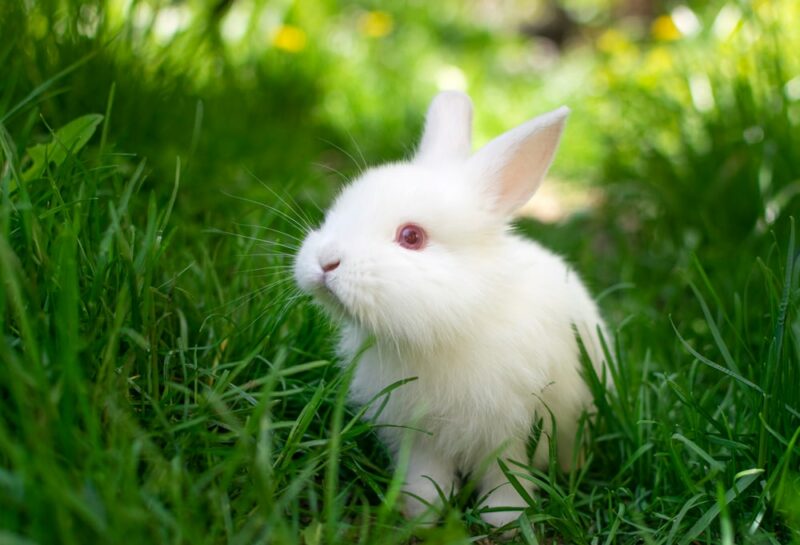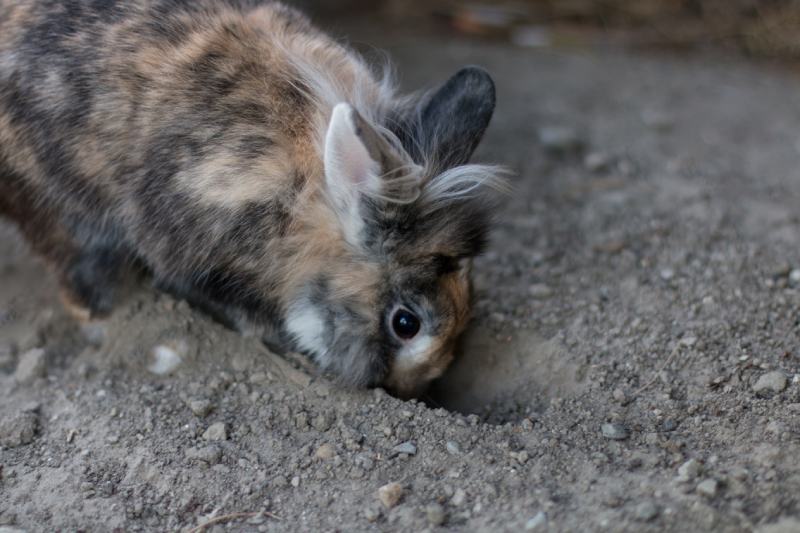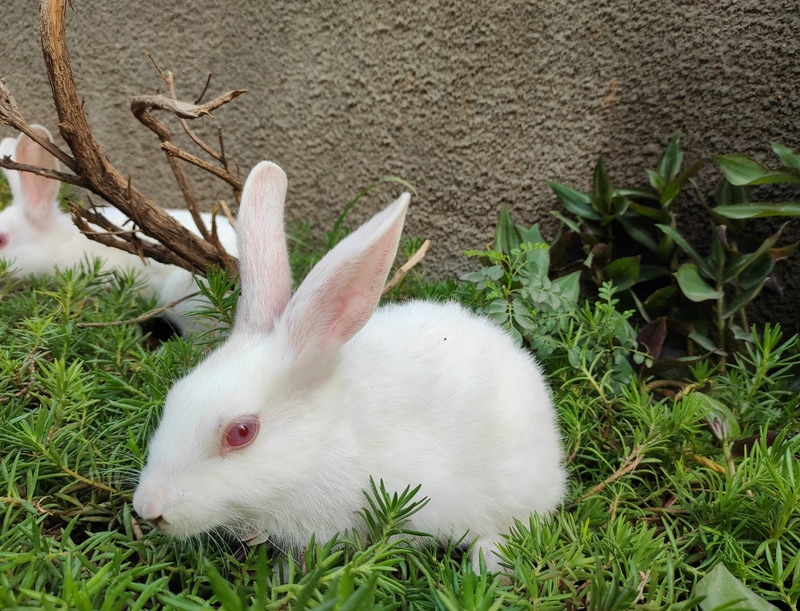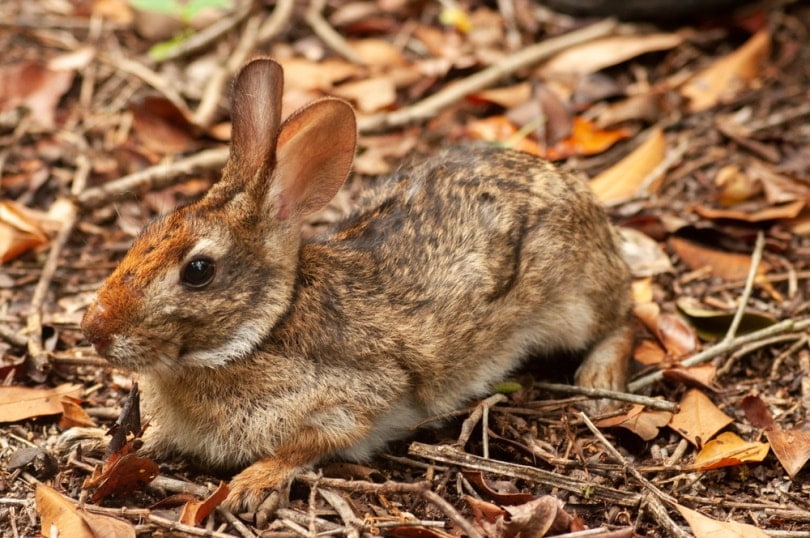White Vienna Rabbit: Facts, Care, Health & Pictures
By Brooke Bundy
Updated on

If you like white rabbits but feel uncomfortable staring into their glaring red eyes, you’ll appreciate the White Vienna Rabbit. Thanks to the “Vienna” gene, their naturally blue eyes are as soft as their plush fur. Their temperament matches their appearance. These calm creatures are more likely to cuddle with you than some feistier breeds such as the Belgian Hare, which makes them a great match for small children. Finding one to adopt may prove to be the most difficult thing about this breed, however, since they’re not yet abundant in the United States. Let’s learn everything you need to know about this rabbit breed in this article.
| Size: | Standard |
| Weight: | 8–12 pounds |
| Lifespan: | 6–12 years |
| Similar Breeds: | American Rabbit, Flemish Giant, Holland Lop |
| Suitable for: |
Laidback, quiet people who would love to spend their time cuddling with a small creature
|
| Temperament: | Quiet, calm, sweet-tempered |
The White Vienna Rabbit is well-proportioned and muscular. Their cylindrical bodies usually weigh no more than 12 pounds, which makes them a standard sized rabbit. As a breed, the White Vienna Rabbit has a slightly longer life expectancy than the average domestic hare, which only lives around 8 years.
White Vienna Rabbit Characteristic
How Much Do These Rabbits Cost?
Although they’re a hit overseas, the White Vienna Rabbit isn’t recognized as a distinct breed by the American Rabbit Breeders Association in the United States. They remain relatively rare in America and may be called by different names. Some breeders may refer to them as a Blue Eyed White since the official breed name currently isn’t recognized. However, you’ll need to make sure they have the Vienna gene that’s responsible for the soft blue look. Otherwise, you may end up with a white bunny with red-rimmed eyes that isn’t a true Vienna. A White Vienna Rabbit in the US will cost hundreds of dollars from a reputable breeder, but you might be lucky enough to find one from a shelter or rescue for less.
Temperament & Intelligence of the White Vienna Rabbit
The parent breeds of the White Vienna, the Holland Lop and the Flemish Giant couldn’t be more different, yet the White Vienna is a genius combination of both beloved breeds. They inherited the Flemish Giant’s gentle demeanor coupled with the Holland Lop’s relatively small size.
While most white rabbits have startlingly red eyes, the White Vienna Rabbit always possesses darling blue eyes due to a recessive “Vienna” gene. Their fur is always pure white and soft as cotton
Do These Rabbits Make Good Pets? 👪
In general, the White Vienna Rabbit is a gentle creature that makes an excellent pet. Due to their low-maintenance nature, they’re also excellently suited for first time rabbit owners. No matter the breed, it’s always crucial to teach small children how to properly handle a pet rabbit so they don’t get bit or hurt their bunny.
Does This Rabbit Get Along With Other Pets?
As long as they’re calm (i.e., not trying to aggressively chase them), a White Vienna Rabbit should get along well with other pets. It’s best if you adopt your rabbit first and then bring home a puppy or kitten, as opposed to bringing a bunny home to an adult animal that may feel territorial, or think of the newcomer as a snack. If you must adopt the bunny after the dog or cat, you should introduce them slowly and always make the rabbit’s safety your first priority. If the situation doesn’t feel safe, you might have to sequester your pets to different areas of the house, so your rabbit doesn’t become stressed.
While it might be tempting to buy another bunny as a “friend,” you should know that bunnies of the same sex are actually often aggressive towards each other. Males fight with other males, and the same is true for females. A male and a female will get along just fine…and bring an abundance of bunnies your way in just a few weeks if they haven’t been spayed or neutered!
Things to Know When Owning a White Vienna Rabbit
Food & Diet Requirements 🥕
Like most domestic rabbits, your White Vienna Rabbit’s diet should mostly consist of high-quality, fiber-rich hay such as Timothy hay, as well as fresh green vegetables and a limited amount of pellets. Their dietary requirements change as they age. For example, young bunnies are often given alfalfa hay, which is healthy in that life stage because it promotes healthy growth. However, adult rabbits shouldn’t eat alfalfa hay because it contains too much protein and calcium for their needs at that life stage, which could contribute to bladder stones.
As long as it doesn’t give them an upset tummy, you should allow your rabbit to feast on fresh veggies to their heart’s content. Despite the popular depiction of rabbits crunching on carrot roots, leafy greens such as the carrot tops are a healthier choice than the carrots themselves. Pellets help supplement their diet but watch their portions because too many can lead to obesity.
If you’re an early riser, beware: rabbits do eat their own poop in the wee hours of the morning. It’s normal for them, so don’t panic.
Habitat & Hutch Requirements 🏠
The White Vienna Rabbit is a standard-sized breed that requires a large enclosure to thrive. Keeping their cage clean and replacing the bedding weekly helps prevent diseases that can seriously curtail their lifespan. Whether you give them a sipper bottle or a water dish, your rabbit should have a continuous supply of filtered water to keep them hydrated and healthy.
Exercise & Sleeping Needs 🐇
While they’ll still need exercise to thrive, the White Vienna Rabbit generally has a laid-back temperament that’s well-suited for quiet households. You’ll need to make sure your rabbit spends at least 4–5 hours outside of their enclosure every day—preferably close to you—to be happy. If you decide to let your rabbit play outside, always supervise them to make sure they don’t escape your yard or get attacked by a predator.
Grooming ✂️
Bi-weekly brushing is the price required for the White Vienna Rabbit’s plush coat. You may need to brush them even more often during the spring and fall when they’re molting. Other than that, the White Vienna is easy to care for and doesn’t have any breed-specific grooming requirements. As with all rabbits, regular nail trims are a must.
Lifespan and Health Conditions 🏥
The White Vienna Rabbit doesn’t have any known medical conditions. Their relatively long lifespan suggests that they are a healthy breed, but their individual lifespan depends mostly on how you care for them.
When you first adopt your rabbit, you should take them to the vet for them to receive their vaccines. You should also talk to your vet about flea prevention if your rabbit will be spending a lot of time outside, or if you have other animals.
Male vs Female
“Everybunny” has a different personality, but male rabbits tend to be more relaxed than females. They’re usually up for a snuggle and are generally less aggressive to humans than females. However, grouping two rabbits of the same sex almost always results in fights, so you’ll probably want to adopt a pair of rabbits of different sexes if you want more than one. Both male and female rabbits spray, so you might consider neutering or spaying them to reduce certain unwanted behaviors, unless you want a litter.
The 3 Little-Known Facts About the White Vienna Rabbit
1. The White Vienna Rabbit is a distinct breed
According to the British Rabbit Council, the White Vienna Rabbit is a different breed from other Vienna Rabbits. The word “Vienna” refers to the recessive gene that makes their eyes naturally blue.
2. They’ve existed for over a century
Wilhelm Mucke, an Austrian breeder, developed the White Vienna during the late 1800s. Although other rabbit breeders ridiculed his unique development, the White Vienna breed quickly became one of the most popular rabbit breeds in Europe. Interestingly, the trend didn’t catch on in the United States, where they remain relatively rare.
3. Their ears are furred
All rabbits obviously have some fur on their ears. However, these hairs tend to be very short and thin, whereas the White Vienna grows the same 1-inch thickness of fur on their ears as the rest of their body.
Final Thoughts
Snowy white with gentle blue eyes, the White Vienna Rabbit behaves as it appears, with a calm demeanour well-suited for children and first-time pet parents. Even though the breed has existed for over a century, they’re still hard to find in the United States. You can expect to pay at least a couple of hundred dollars from a reputable breeder unless you can find a rescue.
Featured Image Credit to: Rastkobelic, Shutterstock












